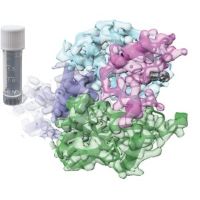Specification
| Description | Recombinant protein from the full-length sequence of homo sapiens SWI/SNF related, matrix associated, actin dependent regulator of chromatin, subfamily a, member 1 (SMARCA1), transcript variant 1 (NM_003069). |
| Organism | Homo sapiens (Human) |
| Expression Host | Human Cells |
| Tag Info | His or DYKDDDDK. Please contact us if you need further information or require specific designed tag. |
| Purity | Greater than 90% by SDS-PAGE gel |
| Uniprot ID | P28370 |
| Entry Name | SMCA1_HUMAN |
| Gene Names | SMARCA1 SNF2L SNF2L1 |
| Alternative Gene Names | SNF2L SNF2L1 |
| Alternative Protein Names | Probable global transcription activator SNF2L1 (EC 3.6.4.-) (ATP-dependent helicase SMARCA1) (Nucleosome-remodeling factor subunit SNF2L) (SWI/SNF-related matrix-associated actin-dependent regulator of chromatin subfamily A member 1) |
| Application | Antigens, Western, ELISA and other in vitro binding or in vivo functional assays, and protein-protein interaction studies; For research & development use only! |
| Buffer | Purified protein formulated in a sterile solution of PBS buffer, pH7.2, without any preservatives |
| Endotoxin | Endotoxin level is < 0.1 ng/µg of protein (<1EU /µg) |
| Length | 1054 |
| Molecular Weight(Da) | 122605 |
| Protein Sequence | (The sequence of expressed protein may have some variation from the sequence shown below. Please contact us for the exact sequence.) MEQDTAAVAATVAAADATATIVVIEDEQPGPSTSQEEGAAAAATEATAATEKGEKKKEKNVSSFQLKLAAKAPKSEKEMDPEYEEKMKADRAKRFEFLLKQTELFAHFIQPSAQKSPTSPLNMKLGRPRIKKDEKQSLISAGDYRHRRTEQEEDEELLSESRKTSNVCIRFEVSPSYVKGGPLRDYQIRGLNWLISLYENGVNGILADEMGLGKTLQTIALLGYLKHYRNIPGPHMVLVPKSTLHNWMNEFKRWVPSLRVICFVGDKDARAAFIRDEMMPGEWDVCVTSYEMVIKEKSVFKKFHWRYLVIDEAHRIKNEKSKLSEIVREFKSTNRLLLTGTPLQNNLHELWALLNFLLPDVFNSADDFDSWFDTKNCLGDQKLVERLHAVLKPFLLRRIKTDVEKSLPPKKEIKIYLGLSKMQREWYTKILMKDIDVLNSSGKMDKMRLLNILMQLRKCCNHPYLFDGAEPGPPYTTDEHIVSNSGKMVVLDKLLAKLKEQGSRVLIFSQMTRLLDILEDYCMWRGYEYCRLDGQTPHEEREDKFLEVEFLGQREAIEAFNAPNSSKFIFMLSTRAGGLGINLASADVVILYDSDWNPQVDLQAMDRAHRIGQKKPVRVFRLITDNTVEERIVERAEIKLRLDSIVIQQGRLIDQQSNKLAKEEMLQMIRHGATHVFASKESELTDEDITTILERGEKKTAEMNERLQKMGESSLRNFRMDIEQSLYKFEGEDYREKQKLGMVEWIEPPKRERKANYAVDAYFREALRVSEPKIPKAPRPPKQPNVQDFQFFPPRLFELLEKEILYYRKTIGYKVPRNPDIPNPALAQREEQKKIDGAEPLTPEETEEKEKLLTQGFTNWTKRDFNQFIKANEKYGRDDIDNIAREVEGKSPEEVMEYSAVFWERCNELQDIEKIMAQIERGEARIQRRISIKKALDAKIARYKAPFHQLRIQYGTSKGKNYTEEEDRFLICMLHKMGFDRENVYEELRQCVRNAPQFRFDWFIKSRTAMEFQRRCNTLISLIEKENMEIEERERAEKKKRATKTPMVKFSAFS |
Background
| Function | FUNCTION: [Isoform 1]: Catalytically inactive when either DNA or nucleosomes are the substrate and does not possess chromatin-remodeling activity (PubMed:15310751, PubMed:28801535). Acts as a negative regulator of chromatin remodelers by generating inactive complexes (PubMed:15310751). {ECO:0000269|PubMed:15310751, ECO:0000269|PubMed:28801535}.; FUNCTION: [Isoform 2]: Helicase that possesses intrinsic ATP-dependent chromatin-remodeling activity (PubMed:15310751, PubMed:14609955, PubMed:15640247, PubMed:28801535). ATPase activity is substrate-dependent, and is increased when nucleosomes are the substrate, but is also catalytically active when DNA alone is the substrate (PubMed:15310751, PubMed:14609955, PubMed:15640247). Catalytic subunit of ISWI chromatin-remodeling complexes, which form ordered nucleosome arrays on chromatin and facilitate access to DNA during DNA-templated processes such as DNA replication, transcription, and repair (PubMed:15310751, PubMed:14609955, PubMed:15640247, PubMed:28801535). Within the ISWI chromatin-remodeling complexes, slides edge- and center-positioned histone octamers away from their original location on the DNA template (PubMed:28801535). Catalytic activity and histone octamer sliding propensity is regulated and determined by components of the ISWI chromatin-remodeling complexes (PubMed:28801535). The BAZ1A-, BAZ1B-, BAZ2A- and BAZ2B-containing ISWI chromatin-remodeling complexes regulate the spacing of nucleosomes along the chromatin and have the ability to slide mononucleosomes to the center of a DNA template (PubMed:28801535). The CECR2- and RSF1-containing ISWI chromatin-remodeling complexes do not have the ability to slide mononucleosomes to the center of a DNA template (PubMed:28801535). Within the NURF-1 and CERF-1 ISWI chromatin remodeling complexes, nucleosomes are the preferred substrate for its ATPase activity (PubMed:14609955, PubMed:15640247). Within the NURF-1 ISWI chromatin-remodeling complex, binds to the promoters of En1 and En2 to positively regulate their expression and promote brain development (PubMed:14609955). May promote neurite outgrowth (PubMed:14609955). May be involved in the development of luteal cells (PubMed:16740656). {ECO:0000269|PubMed:14609955, ECO:0000269|PubMed:15310751, ECO:0000269|PubMed:15640247, ECO:0000269|PubMed:16740656, ECO:0000269|PubMed:28801535}. |
| Pathway | |
| Protein Families | SNF2/RAD54 helicase family, ISWI subfamily |
| Tissue Specificity |
QC Data
| Note | Please contact us for QC Data |
| Product Image (Reference Only) |  |

